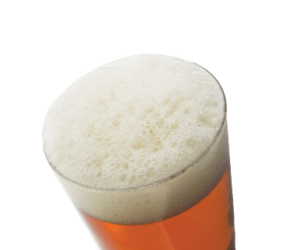Blondinebier
Blondinebier
(5 gallons/19 L, all-grain)
OG = 1.049 (12.2 °P) FG = 1.011 (2.8 °P)
IBU = 20 SRM = 5 ABV = 5%
Ingredients
10 lb. (4.53 kg) North American 2-row malt (2 °L)
0.5 lb. (227 g) crystal malt (15 °L)
4.1 AAU Willamette hops (60 min) (0.82 oz./23 g of 5% alpha acids) or
substitute with Glacier, U.S. Fuggle, U.S. Tettnang or Styrian Golding hops
Wyeast 1056 (American Ale), White Labs WLP001 (California Ale) or Fermentis Safale US-05 yeast
3/4 cup corn sugar (if priming)
Step by Step
Mill the grains and dough-in targeting a mash of around 1.5 quarts of water to 1 pound of grain (a liquor-to-grist ratio of about 3:1 by weight or 3.1 L/kg) and a temperature of 152 °F (67 °C). Hold the mash at 152 °F (67 °C) until enzymatic conversion is complete. Infuse the mash with near boiling water while stirring or with a recirculating mash system raise the temperature to mash out at 168 °F (76 °C). Sparge slowly with 170 °F (77 °C) water, collecting wort until the pre-boil kettle volume is around 6.5 gallons (25 L) and the gravity is 1.038 (9.5 °P).
The total wort boil time is 90 minutes. Add the bittering hops with 60 minutes remaining in the boil. Add Irish moss or other kettle finings with 15 minutes left in the boil. Chill the wort to 67 °F (19 °C) and aerate thoroughly. The proper pitch rate is 9 grams of properly rehydrated dry yeast, two packages of liquid yeast or one package of liquid yeast in a 1.4 quart (1.3 L) starter.
Ferment at 67 °F (19 °C) until the yeast drops clear. At this temperature and with healthy yeast, fermentation should be complete in about one week. Allow the lees to settle and the brew to mature without pressure for another two days after fermentation appears finished. Rack to a keg and force carbonate or rack to a bottling bucket, add priming sugar, and bottle. Target a carbonation level of 2.5 volumes.
Blondinebier
(5 gallons/19 L, extract with grains)
OG = 1.049 (12.1 °P) FG = 1.011 (2.8 °P)
IBU = 20 SRM = 5 ABV = 5%
Ingredients
6.3 lb. (2.85 kg) light liquid malt extract (2 °L) or substitute 5.1 lbs. (2.3 kg) light dried malt extract
0.5 lb. (227 g) crystal malt (15 °L)
4.1 AAU Willamette hops (60 min) (0.82 oz./23 g of 5% alpha acids)
or substitute with Glacier, U.S. Fuggle, U.S. Tettnang, or Styrian Golding hops
Wyeast 1056 (American Ale), White Labs WLP001 (California Ale) or Fermentis Safale US-05 yeast
3/4 cup corn sugar (if priming)
Step by Step
Mill or coarsely crack the specialty malt and place loosely in a grain bag. Avoid packing the grains too tightly in the bag, using more bags if needed. Steep the bag in about 0.5 gallons (~2 L) of water at roughly 170 °F (77 °C) for about 30 minutes. Lift the grain bag out of the steeping liquid and rinse with warm water. Allow the bags to drip into the kettle for a few minutes while you add the malt extract. Do not squeeze the bags. Add enough water to the steeping liquor and malt extract to make a pre-boil volume of 5.9 gallons (22.3 L) and a gravity of 1.042 (10.4 °P). Stir thoroughly to help dissolve the extract and bring to a boil.
Once the wort is boiling, add the bittering hops. The total wort boil time is one hour after adding the bittering hops. During that time add the Irish moss or other kettle finings at 15 minutes before shut-down.
Chill the wort to 67 °F (19 °C) and aerate thoroughly. The proper pitch rate is 9 grams of properly rehydrated dry yeast, 2 packages of liquid yeast or 1 package of liquid yeast in a 1.3 liter starter.
Ferment at 67 °F (19 °C) until the yeast drops clear. At this temperature and with healthy yeast, fermentation should be complete in about one week. Allow the lees to settle and the brew to mature without pressure for another two days after fermentation appears finished. Rack to a keg and force carbonate or rack to a bottling bucket, add priming sugar, and bottle. Target a carbonation level of 2.5 volumes.
Written by Jamil Zainasheff

Jamil Zainasheff’s provides a classic blonde ale recipe to provide a subtly complex, yet easy drinking ale. The perfect lawnmower beer.


